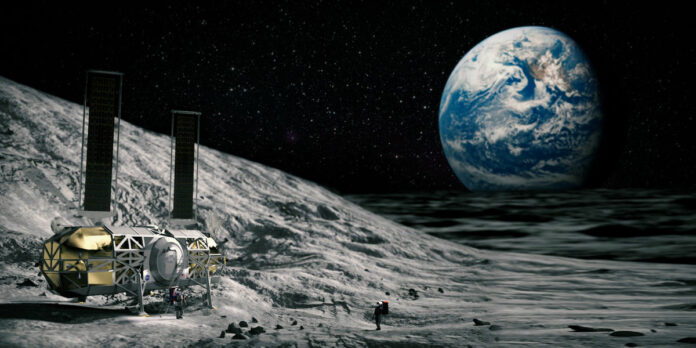Each year, July 20 marks the anniversary of one of humanity’s biggest triumphs: Landing on the moon. In 1969, American astronauts Neil Armstrong and Buzz Aldrin became the first humans to experience that “giant leap for mankind.”
Few events in history capture the imagination as vividly as the launch of Apollo 11, its successful lunar landing, and fundamentally, the innovation that made it all possible.
Those feats of science, engineering, technology and American ambition are directly traceable to the work being done today by the National Aeronautics and Space Administration.
As NASA passes Apollo’s torch to Artemis with the goal of returning humans to the moon by 2025, the agency is unlocking groundbreaking partnerships with companies like Leidos, which employ a vast range of interrelated capabilities in service of a cosmic mission more ambitious than ever.
“This time, we’re not just going to the moon to leave footprints,” said Jonathan Pettus, Senior Vice President of Aerospace, Civil and Defense Operations for the Dynetics Group at Leidos.
“We’re going there to do work on the moon, including scientific exploration,” he told 256 Today.
Pettus spent most of his 27-year career with NASA at the Marshall Space Flight Center in Huntsville and was inspired from an early age by the later Apollo missions.
“The United States wouldn’t have gotten to the moon without Huntsville, Alabama,” he said. “The impact missions here had on multiple generations is immeasurable. They promoted the idea that science, engineering and technology are exciting fields that offer limitless possibilities.”
Huntsville’s connection to the achievements of the American space program runs deep.
Going back to the development of the 1960s-era Saturn V rocket that first landed humans on the moon — all the way to its current day involvement with the Artemis missions and the Space Launch System (SLS) — North Alabama’s position as the epicenter of a renewed surge in the U.S. space economy is undoubtedly poetic.
A major component of the next lunar mission will be to cover a lot more terrain this time around.
Leidos and its Dynetics team are competing to develop the next vehicle astronauts will use to navigate the surface of the moon. Earlier this year, they rolled out their Lunar Terrain Vehicle (LTV) concept in a uniquely-synergistic collaboration with NASCAR.
“NASA is looking at the ability to create a habitat on the lunar surface to create power systems on the moon,” Pettus said. “And when you do that, you need to actually move things around on the surface, perhaps you need to dig trenches, pull cable, so there’s a utility to this beyond just moving crew around and conducting science experiments.”
“It is designed to be a multi-purpose vehicle that can be used for a variety of purposes long term to help, as NASA would say, ‘grow the lunar economy.’”
Leidos and its Huntsville-based Dynetics team maintains a longstanding reputation of innovation, reliability and the competitive edge of leveraging diverse capabilities to meet the dynamic needs of customers like NASA.
Those deliveries include hardware components of the Space Launch System, a laser air monitoring system to ensure the safety of the astronauts and delivering comprehensive information technology systems that enable NASA to conduct its missions.
In essence, if it deals with getting astronauts to space, staying in communication with them from 238,900 miles away, analyzing what they find, and getting them home safely — Leidos has a role in that process.
Pettus pointed to a changing industry in which even traditional players are still getting accustomed. Bold, smart innovation is no longer a benefit as much as it is a requirement.
“The traditional way in which NASA has worked is evolving for the Artemis program by utilizing service contracts to pursue exploration objectives,” Pettus said.
NASA is seeking industry partners who will actually provide a service to NASA that they’ll also could provide to other potentially interested parties. The LTV is a great example of this concept, and our team is excited to engage the American public and other new stakeholders in this way.”
That message is an inspiring one, especially to those who recognize the historic opportunity for NASA missions and contracts to spur innovation available to all Americans.
“As the world changes relative to the space industry, we now realize that almost everything we do on a daily basis relies somehow on space,” Pettus said.
The history currently being written by NASA’s workforce across North Alabama, and everyone, including those involved in even the smallest components of America’s new age space program, has a lot to be proud of 54 years later.
For some like Pettus of Leidos, the excitement sparked decades ago by trailblazers who did the impossible isn’t fading anytime soon.
“We’ve got one of the coolest things on our site right now. You can go to the Decatur facility and see a fully developed universal stage adapter that will be tested. And the size of that thing is unbelievable. That gives you a sense of how big the actual rocket is,” Pettus said.”
“There’s a nice healthy space industry that’s quietly developing along the river there in Decatur, as well, with ULA, Beyond Gravity, us – and we’re really proud of that in North Alabama.”
Don’t miss out! Subscribe to our email newsletter to have all our smart stories delivered to your inbox.



